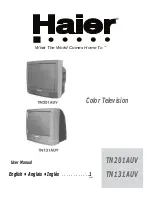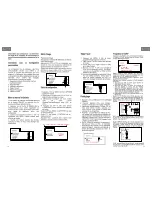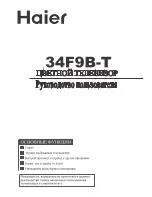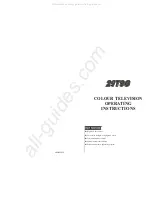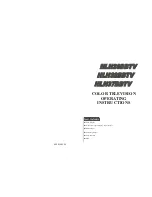
8
Electrical alignments
59
'Option number':
–
All options together, expressed in two long numbers. The
original factory setting for these numbers can be found on
the picture tube sticker on the inside of the set.
'Store':
–
Store all alignments.
The alignments are explained now in the sequence of the sub-
menu:
8.5.2
General alignments in Service Alignment Menu:
•
Once all alignments/settings have been completed the
item 'Store' must be selected to record all the values in the
permanent memory of the set.
•
If the option codes have been changed and stored, the set
has to be switched on and off using the mains switch to
activate the new settings (when switching on and off via
Standby, the option code settings are NOT read by the
microprocessor).
•
If an empty EAROM (permanent memory) is detected, all
settings are set to pre-programmed default (standard)
values.
•
A built-in test pattern can be called up in various sub-
menus. The test pattern generator can be switched on
using the item 'Test pattern on/off'. The test pattern only
appears AFTER the specific alignment has been selected.
The test patterns are generated by the teletext-IC.
'Drive'
Tint-settings:
Set the white levels for the three tint-settings 'Normal' . 'Warm'
and 'Cool' is calculated by the processor then ('Warm': R+4, B-
7 and 'Cool': R-3, B+3) For 4:3 picture tubes (25" and 29") the
next values must be entered:
'Cathode':
This alignment must also be covered by a table with values for
all picture-tube sizes. For 4:3 picture tubes (25" and 29")
following value must be entered: 5
For wide screen picture tubes (24", 28" and 32") following value
must be entered:2
'Peak White Limiter'
Dependent of the picture-tube size (25", 29", and 24"/28"/32"
widescreen tubes) the next value of the table must be entered:
'Luminance delays'
With the 'Luminance delays' alignment the luminance
information is placed on the chrominance information
(brightness is pushed onto the colour). Use a colour bar/grey
scale pattern as test signal.
•
Lum. Delay Pal: Apply a PAL colour bar/grey scale pattern
as a test signal. Adjust 'Lum. Delay Pal' until the transients
of the colour part and black and white part of the test
pattern are at the same position.
•
Lum. Delay Secam: Apply a SECAM colour bar/grey scale
pattern as a test signal. Adjust 'Lum. Delay Pal' until the
transients of the colour part and black and white part of the
test pattern are at the same position.
•
Lum. Delay Bypass: Apply a NTSC colour bar/grey scale
pattern as a test signal. Adjust 'Lum. Delay Bypass' until
the transients of the colour part and black and white part of
the test pattern are at the same position.
'EHT compensation'
Fixed value:
0
'Soft clipper"
Fixed setting:
'Pwl+0%'
'Luma gain'
Fixed value:
1
'IF AFC'
See chapter 8.4.1. The SAM-mode is needed to make
alignment, a test generator to make signal, an oscilloscope to
measure at SCART-output and the Install-menu to check fine-
tuning-value.
'Tuner AGC'
See chapter 8.4.2. The SAM-mode is needed to make
alignment, a test generator to make signal, a DC-Voltmeter to
measure at pin 1 of Tuner.
8.5.3
Geometry alignments 'Normal Geometry' in the Service
Alignment Menu
Warning:
At this moment the INTERNAL test pattern of the set will lead
to a misaligned geometry of the picture. Please do not use
internal test pattern. When using a service generator with a
geometry-pattern (e.g. a crosshatch-pattern), the set can be
aligned without problems.
Vertical amplitude and centring
Select 'Test Pattern on' and set the begin conditions for 4:3
sets (25", 28" and 29"):
–
Vertical S-correction value on 13 for 29"-set, and on 19 for
the 25"- and 28"-sets.
The boundary-stripes of the test pattern should be positioned
on the edge of the picture tube. Set the begin conditions for
16:9 sets (24", 28", 32"):
–
Vertical S-correction value on 7 for 24"-set, on 8 for the 28"
and on 7 for the 32"-set.
The boundary-stripes of the test pattern should be positioned
on the edge of the picture tube.
Cool
Normal
Warm
R
22
25
29
G
20
20
20
B
17
14
7
24"
10
25"
10
28"
10
29"
10
32"
10































